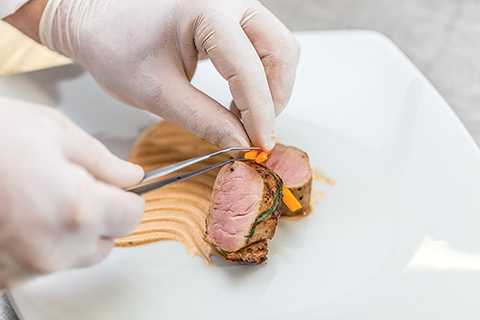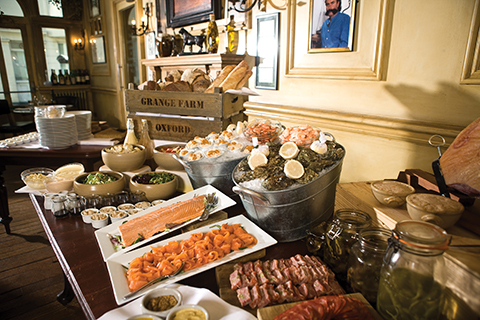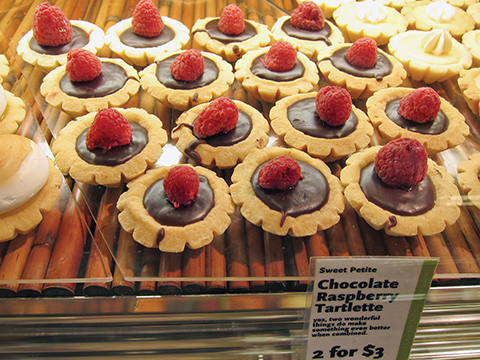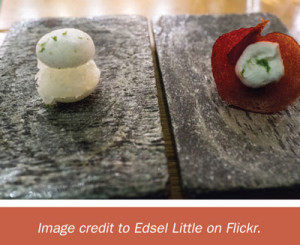 Beautiful looking food ought to have an appropriate canvas to be presented. Many chefs have used unconventional items like tiles, cutting boards or oddly shaped cutlery to serve up their creations as a way for diners to remember the experience. Stark white coloured plates are still in demand because its neutrality allows the chef wider range of plating explorations but many chefs also desire to have a little extra in the mix. In remembering that “subtlety is class”, how can one select the appropriate tableware and cutler y that reflects the entire storyline of the establishment?
Beautiful looking food ought to have an appropriate canvas to be presented. Many chefs have used unconventional items like tiles, cutting boards or oddly shaped cutlery to serve up their creations as a way for diners to remember the experience. Stark white coloured plates are still in demand because its neutrality allows the chef wider range of plating explorations but many chefs also desire to have a little extra in the mix. In remembering that “subtlety is class”, how can one select the appropriate tableware and cutler y that reflects the entire storyline of the establishment?
DISHWARE
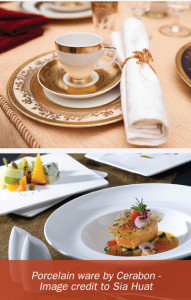 The often used material for tableware in fine dining places are bone china and porcelain. According to Sylvie Amar, both are quite similar in terms of material quality but the shades of white differentiate them. Sia Huat, a company that supplies tableware as par t of its repertoire, explains that porcelain has a cream/grey white colour, fine bone china is off white whilst bone china comes in a high level of white, is translucent, thinner than most materials yet is highly chip resistant. Sylvie does not recommend both porcelain and bone china be used together on the table because the contrast would make the porcelain look dated.
The often used material for tableware in fine dining places are bone china and porcelain. According to Sylvie Amar, both are quite similar in terms of material quality but the shades of white differentiate them. Sia Huat, a company that supplies tableware as par t of its repertoire, explains that porcelain has a cream/grey white colour, fine bone china is off white whilst bone china comes in a high level of white, is translucent, thinner than most materials yet is highly chip resistant. Sylvie does not recommend both porcelain and bone china be used together on the table because the contrast would make the porcelain look dated.
If you want to jazz up the tableware throughout the dinner, she suggests alternating modern, sleek plates with antiquity between courses to create a nice balance of pattern and colour. Tableware is meant to enhance the visual perception of the food item it holds and Sylvie illustrates that the French bouillon is a clear broth and using a transparent or white colour bowl best brings out the translucent element of the liquid.
GLASSWARE
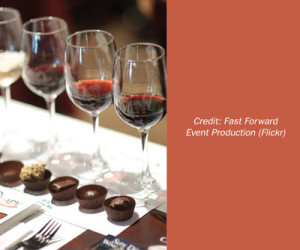 Another important aspect of the table setting are the glasses. After all, some may refer to such outings as “wining and dining”. Sia Huat recommends high-end restaurants or luxury hotels to select glass made with silica and lead oxide with other compounds in small amounts. These compounds provide higher density and elasticity which result in better clarity and brilliance; matching the luxefactor. It is also thinner than glass and available in more unique shapes. However, they are typically not dishwasher safe and require detailed polishing by hand.
Another important aspect of the table setting are the glasses. After all, some may refer to such outings as “wining and dining”. Sia Huat recommends high-end restaurants or luxury hotels to select glass made with silica and lead oxide with other compounds in small amounts. These compounds provide higher density and elasticity which result in better clarity and brilliance; matching the luxefactor. It is also thinner than glass and available in more unique shapes. However, they are typically not dishwasher safe and require detailed polishing by hand.
CUTLERY / FLATWARE
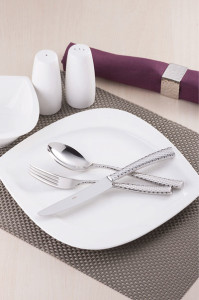 Heavy silver ware has traditionally been associated with fine dining. While some places may still use them, stainless steel is favoured nowadays. There are two classifications which are 18/10 and 18/0 which mean the amount of chromium and nickel content used in the production:
Heavy silver ware has traditionally been associated with fine dining. While some places may still use them, stainless steel is favoured nowadays. There are two classifications which are 18/10 and 18/0 which mean the amount of chromium and nickel content used in the production:
Chromium: tough white metal that is hard and stain-resistant.
Nickel: a silver y-white metal that is corrosion-resistant.
18/10 = 18% chromium and 10% nickel content.
• Chromium by itself is not considered rust-resistant but when combined with nickel, will result in better durability. With a brighter, polished look, flatware in this category would cost more.
18/0 = 18% chromium and 0% nickel matter.
• The absence of nickel provides a soft sheen and economic value of cutlery in this category, thereby suitable for high volume or casual establishments.
SPECIAL ITEMS
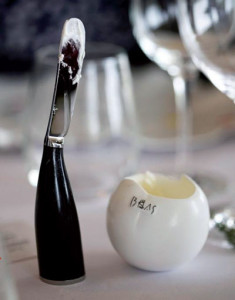 Restaurateurs can also use tableware as par t of its branding. For example, a specially designed butter knife, a range of serving platters that matches its menu or even the visibility of a logo on the napkin can
Restaurateurs can also use tableware as par t of its branding. For example, a specially designed butter knife, a range of serving platters that matches its menu or even the visibility of a logo on the napkin can
help create brand retention. Having said that, Sylvie says that these additional elements should be very natural; in some cases having to be comfortable in ergonomics for diners to handle if they are special utensils for certain food or cutlery.

If you entered a retail outlet specialising in tableware, there is no shortage of unconventional designs to choose from and its a chefs’ playground to showcase their masterpiece. Yet, it is always good to look back at the fundamentals which still stands today – what and where to place tableware and cutlery in a fine dining setting.







